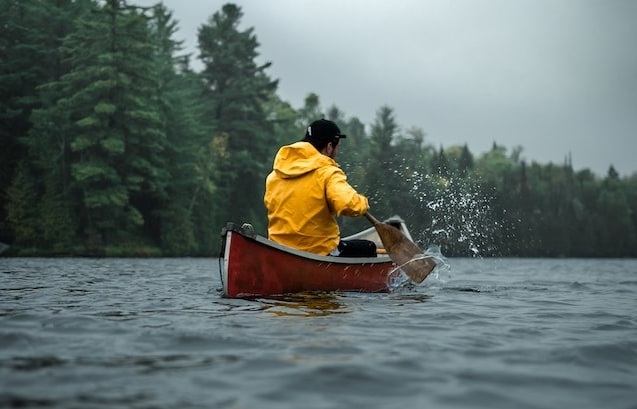The canoe J-Stroke is probably the most important canoe stroke to learn yet most recreational canoeists don’t even know it exists. Every person who has ever sat in a canoe knows how difficult it is to keep it going straight. The reason for this is that with every stroke of the paddle, the canoe wants to turn to the opposite side. The canoe j-stroke along with the draw stroke, is the remedy to this problem and actually allows the canoeist to correct the direction of the canoe while paddling forward.
Difficulty: Average
Time Required: A few times out on the water
Here’s How:
Canoe J-Stroke: Maintaining Proper Form
Be sure that you are holding the canoe paddle properly and that you are sitting up straight throughout the j-stroke. The basic motion of the canoe J-stroke is to move the paddle in a J-shape on both the forward and return strokes
1. The Beginning
Similar to the forward stroke, the j-stroke begins the same way. Raise the paddle up, bringing the top hand up to about head level while keeping the shaft of the paddle vertical and out to the side and not angled across the body.
2. Reach Forward
Push the lower hand forward, reaching the paddle blade as far toward the front of the canoe as you can while still maintaining a good upright posture.
3. The Catch Phase
Place the paddle blade into the water ahead of your body. Keep the face of the blade perpendicular to the direction of the stroke.
4. The Power Phase
Pull the paddle along the side of the canoe in a straight line. Allow the top hand to push forward and down while the bottom hand pulls back.
5. Upper Body Involvement
Use the torso and upper body rotation to aid in the stroke to give maximum power. You shouldn’t be using your arms as much as you use the rotation of your torso.
6. Twist the Canoe Paddle
Toward the end of the stroke, begin to rotate the canoe paddle blade from pulling the canoe into a ruddering position by twisting your top hand down. The thumb on the top hand should be facing downward at this point.
7. The “J”
With the paddle now in a rudder position, the bottom hand pushes the paddle out from the canoe. The entire stroke would look something like a “J” from up above. This part of the j-stroke serves to correct the position of the canoe if it rotated during the power phase of the stroke.
8. The Recovery
Remove the canoe paddle from the water and go back to step 2.
Tips on Perfecting the J Stroke
- You may get sore while practicing this stroke. Don’t worry, it will go away and you’ll be better off for it.
- The more accustomed you become to this stroke, the more you’ll know how much to push out a the end of this stroke.
- Only rudder or push out during the “j” part of the stroke as much is needed to keep the canoe moving straight.
- The canoe j-stroke is meant to be employed by the canoeist in the stern (rear) of the canoe to keep the canoe moving in a straight line.
- The canoeist in the bow (front of the canoe) should paddle on the opposite side from the person in the stern and he or she should use the forward stroke.
What You Need:
- Canoe
- Paddle
- PFD

